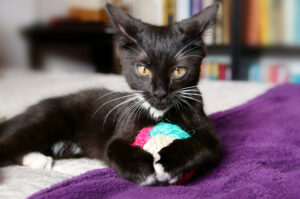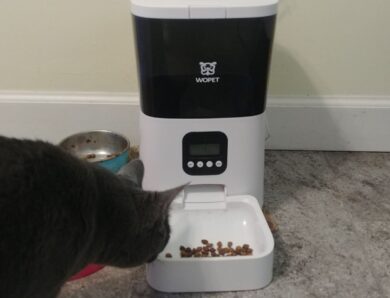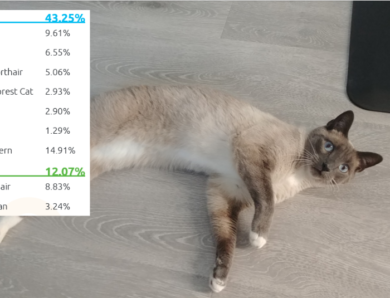
The Benefits of Playing with Your Cat
All cats play. Don’t let anyone tell you otherwise. Only partially tamed, cats are hardwired to hunt, which they practice doing as kittens through play. As they get older, and if they’re indoor cats (for which Keeping It Pawsome strongly advocates), play continues to be the only way cats can meet their instinctual needs to stalk, chase, and catch prey.
But the benefits of playing with your cat go beyond just meeting their biological needs.
Play also keeps them stimulated, engaged, and healthy. After all, a cat that spends part of the day running around or jumping after a flying feather will always be in better shape than one that just lies around all day.
When it comes to how to play with cats, there are two types you want to provide your kitty: solo and interactive.
Solo Cat Play

Solo toys are those you can leave out for cats to play with independently. Things like soft, crinkly, sisal, or bouncy balls, stuffed mice, and catnip-filled options.
Make sure to rotate the toys into and out of service. Once a month, take all the toys you’ve left out and put them away. Bring out a new set of options with different textures or shapes. Even finding a toy with a new smell can be exciting for a while. (Alternatively, leave one of the toys in catnip overnight to give it that intoxicating scent for a little while.)
If you find that your cat only likes to play with a specific type of toy and switching that out doesn’t work for him, feel free to get a mix of that type of toy and then rotate those every few weeks.
Homemade Solo Toys
While we do recommend investing in a few store-bought cat toys, you can also make your own. Some people report simply crumpling up a wad of aluminum foil can keep their cat occupied for days. Another option is to make a smaller ball of aluminum foil and put that into an empty toilet paper roll and tape up the sides. Now when your cats bat it around, it’ll feel different and make noise.
One of the easiest DIY toys you can give a cat is an empty box. Cat parents know, cats love boxes! Try different sizes, put tissue paper in the box, cut a hole in one side, sprinkle catnip inside. Each time you do something different, it creates an entirely new experience for your cat to play around with.
If you’re a creative person, try making a cat castle out of a few empty boxes and some cardboard. Leave it out for the day and let them explore.
Interactive Play
The second style of play is interactive play, which most closely simulates hunting.
Also called wand play, because it’s mostly done with a wand-style apparatus to which you can attach all kinds of lures, interactive play stimulates a cat’s need to stalk, chase, and pounce on prey. Try a few different lures (feathers, ribbons, mouse tails, “insects,” balls, etc.) to see which ones are most interesting to your cat.
Don’t just stop after trying one or two lures. All cats enjoy interactive play. If yours doesn’t, you most likely haven’t found the right option yet. If you haven’t yet found a toy your cat likes, you might need to look beyond the big-name or online pet stores. The best toys for cats are those made by cat lovers, and those tend to be sold through specialty cat-only outlets such as ROAR or Meowingtons, as well as select retailers on Amazon.
A Word on Lasers
Cats love laser pointers. Those little red dots are nearly irresistible to them. And they’re cheap and easy to use, making them a favorite with people as well.
But, because lasers aren’t physical, cats never actually get to catch anything. While it might seem like an excellent “hunting” exercise, using a laser pointer actually deprives cats of the full hunt. It’s why most cats never want the game to end. They’re frustrated.
If you’re going to use a laser in your play, try to end the game with the laser light landing on a toy. That way when they finally pounce, they’ll land on something. It’s not a perfect solution. Your cat will know it wasn’t the red dot they “caught” but it’s better than the alternative.
A better option is to use the laser to get a cat up and moving, then try to transition him from chasing the red dot to chasing a wand extension.
How Long Should You Play With Your Cat?
Ten to 15 minutes, at least twice a day is the suggested amount of time to dedicate to interactive play with your cat. But even just a few sessions a week can make a huge difference in your cat’s life.

Learn more about how to keep your kitty from getting bored, and about the dangers boredom presents.
Keep in mind, your cats might not even want to play every day, especially as they get older. And, just like us, cats have their lazy days. They might want to play a full 15 minutes, or they might feel that five was more than enough. Generally speaking, the younger the cat, the longer the play sessions will last.
Our 12-year-old cat likes to chase a laser pointer for a few minutes (we always end the game with the dot on his favorite plush mouse), but he’s usually pooped before we hit the five-minute mark. Other times, he sometimes gets a random burst of energy to run around with the other cats or suddenly bat a ball around. But he’s usually done almost as soon as he’s started.
Never assume your cat is too old to play. His play might be more sedate or last a shorter period of time, but it doesn’t mean he’s any less engaged.
The important thing is to give your cats the option at least a few times a week.
Intra-Cat Play
A common misconception is that having multiple cats means you don’t need to play with any of them because they have each other to play with. Play between cats is important. It reinforces their social bonds and most cats (especially those under three years), love it. But chasing and tumbling with another can’t quite simulate the hunting experience the same way wand play does.
Plus, some cats don’t like rough and tumble play. That doesn’t mean they don’t want to have fun. They’d just rather chase a feather or fetch a ball that you throw (yes, some cats do fetch!), than be jumped on by another cat.
Whether you should separate cats when playing with them should be determined by your cats.
Like humans, cats can be introverted or extroverted. A shy cat that gives way if your other cats are playing together should be given a solo play session.
Other cats prefer to play as a group and have a blast jumping over each other as they try to grab the ribbon before the other ones.
Food as Hybrid Play
One form of enrichment that can almost be considered a type of hybrid play is food puzzles. Because they require thinking, involve a reward, and stimulate the hunter instinct, food puzzles can be a wonderful source of enjoyment for cats.
Food puzzles come in a variety of styles from food-stuffed mice to open-and-close boxes they need to figure out how to manipulate.
See our honest review of the Doc & Phoebe’s indoor hunting cat feeder.





